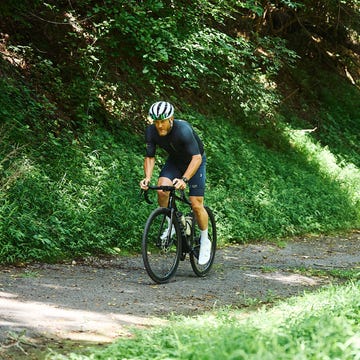Taiwan, 32%; China, 34%; Vietnam, 46%; Cambodia, 49%.
The new “reciprocal” tariff rates shook me because I know more than most other cycling journalists how it will impact bicycle, e-bike, and other cycling gear prices. The new “reciprocal” tariffs take effect on April 5 with across-the-board 10% duties on all imports. Individualized higher rates for specific countries of origin will kick in on April 9.
The duty rates jumped off my iPhone screen as I read the first news reports following the April 2 White House press conference announcing the administration’s new round of tariffs. I froze, reread the percentages, and then checked another story to confirm the numbers. I expected higher duties to be enacted in Donald Trump’s second term, but the rates were higher than I or other experts expected.
Before joining Bicycling, I spent almost twenty years working in product development and sourcing for several bike brands. Over those decades, I became acquainted with the nuances and ever-shifting landscape of duty rates, harmonization codes, and anti-dumping duties into the United States, Canada, the UK, the EU, and other countries.
The Tariff Landscape
Complete bike duty rates were relatively straightforward before tariffs were enacted in President Trump’s first term. The rates were 5.5% for road bikes (“Bicycles having both wheels exceeding 63.5 cm in diameter: If weighing less than 16.3 kg complete without accessories and not designed for use with tires having a cross-sectional diameter exceeding 4.13 cm”) and 11% for most other adult bikes.
Bicycle frame and component duty rates generally ranged from 3.9% to 10% (depending on the specific item and use). Some components, like chains and tires, were duty-free. Electric bikes were also duty-free. No matter which country a brand sourced its bikes, these duty rates were flat. The differences between sourcing in Taiwan or China usually came down to labor costs, complexity of the product, or quantity of the product being produced. As a result, often sourced their entry-to-mid level bikes from China and mid-to-high end bikes from Taiwan for shipments to the United States.
However, Section 301 duties (enacted during Trump’s first term and continued under President Biden’s term) imposed a 25% tariff on Chinese-made e-bikes. This forced brands to shift production for many entry-to-mid-priced bikes (bound for the U.S.) to Cambodia and other countries. Some moved assembly to Vietnam, others to Indonesia or the Philippines. An additional 20% IEEPA tariff imposed earlier this year also impacted goods from China.
I sat in on an April 3 webinar hosted by PeopleForBikes (a US organization that advocates for bicycle “Infrastructure, Policy, and Participation’) about the new tariffs, hoping to gain clarity on the new tariffs. However, aside from the rates announced by the White House and dates they are set to take effect, PFB did not have many additional insights because (as of the time of the call) the U.S. government had yet to publish full details to the Federal Register.
So, will the rates be flat (for example, 32% on goods from Taiwan) or stacked on existing tariffs (32% plus the existing 5.5% bicycle duty)? It is also unclear if these new tariffs will affect current exclusions for some steel and aluminum products.
How Duties Impact Bike Pricing
Unless you purchase factory-direct and import it yourself, the bicycle’s duty rate is already baked into the price. The duty rate is assessed on the amount the importer paid for the goods, not the final sale price. It is a tax on the product that is almost always passed along to consumers.
I contacted several bicycle and component companies to discuss these new tariffs. Some answered that they could not comment, while others did not reply at all. One who got back to me was Mehdi Farsi, co-founder of State Bicycle Co. He predicts the new duties will result in shortages and higher prices. He also stated that MSRP prices will rise “conservatively by 20%.”
Let me give a quick example of how brands calculate bike prices with back-of-the-envelope math based on my time sourcing bicycles. Under the pre-April 5 duty rates, a $4,000 road bike (perhaps a carbon-framed bike with Shimano 105 drivetrain) cost a brand $1,425 to $1,500 from an assembly factory in Taiwan or Cambodia. After duty, shipping, warehouse fees, brand margins, and dealer margins are tallied up, you reach the manufacturer’s suggested retail price.
With the new tariff structure (assuming stacked duties) rolling out for April 9, that same bicycle sees a dramatic price increase. Without any changes to anything except for duty, that $4,000 bike will sell for approximately $5,169 at dealers if sourced from Taiwan. If the bike is assembled in Cambodia, you can tack an extra $500 onto that price.
The sticker shock might be even worse on some components and cycling gear. This is due to the different cost structures brands often apply to these products and the variety of goods and companies selling them. Below is an Instagram story that Orucase founder, Isaac Howe, posted on April 3. This is an idea of how the tariffs will change pricing on the brand’s much-loved travel case.
In a lengthy April 3 blog post on his brand’s site, Rene Herse Cycles’ Jan Heine also provided some insights and analysis about how these tariffs impact the company’s pricing and sourcing strategy. It provides additional context on the history of American bicycle tariffs and details some of the challenges Rene Herse faces.
However, the higher prices will not take hold automatically in most cases. The new duty rates will be applied to products that leave ports beginning on April 5 (or April 9 for the individualized rates). Container ships take about three to four weeks to cross the Pacific Ocean and arrive on the West Coast. Containers of bikes then get delivered to manufacturers’ warehouses and then distributed to bike shops. The process usually takes six weeks or more, so you probably will not see the effects really hit bike prices until the end of May or June.
Ways to Save
This is admittedly a scary time for many Americans—these are uncharted waters for most businesses and consumers. Even with this uncertainty, most of us will not stop riding because bicycles are suddenly more expensive. However, many riders will probably change how, when, and what bikes and gear they buy.
These my five tips to save money on bikes and cycling equipment in the new tariff landscape.
→ Tip 1: Buy A Bike Now
If you want a new bike, don’t hold off until the late spring or summer. Buy that bike now before prices go up. Many bicycle companies and retailers are loaded with excess inventory from a soft bike market in 2023 and 2024. Brands will try to squeeze any extra value from their existing inventory that was purchased at a low price instead of importing the same products at much higher prices.
The first thing you might see rolled back are the excellent deals (like buy-one-get-one, deep discounting, and free shipping). Farsi said in our conversation that “brands will cut all discounting” to hold onto some of that inventory. And after deals dry up, prices may creep up as brands look to hold inventory and avoid paying much more to import replacement stock.
→ Tip 2: Stock Up On Repair Parts
Farsi also noted that there might be runs on parts. Similar to what riders and bike shops experienced during the height of pandemic sourcing challenges in 2020 and 2021, components and repair parts might also be in short supply after the tariffs kick in. Plan ahead to have those parts and keep your bike running smoothly if shortages hit or prices spike.
Some common consumable items—like chains and tires—had no import duties before April 5, while other parts had tariffs at or below 10%. Many popular road bike tires (like Vittoria Corsas) are manufactured in Thailand which will see a 36% duty imposed on April 9. Bicycle chains that are produced in Portugal (an EU country) will face a 20% tariff, and those made in Taiwan will see a 32% rate.
The sudden spike in costs to import these items may cause brands and distributors to reevaluate their product mix. Companies may shift purchasing dollars to lower-cost products, cut back on selection, or even abandon categories if they do not feel they can compete.
My advice is to stock up on parts you know you will use in the short-to-mid term. If you need a chain and cassette, buy them; if you go through brake pads, buy those now. The same goes for tires, saddles, bar tape, derailleurs, shifters, and other parts exclusively made overseas. Some common consumable parts like mountain bike grips and 1x chainrings have domestic sourcing options and might be more readily available if shortages hit or prices spike.
→ Tip 3: Buy America
You can also avoid some of the higher prices by buying a U.S.-made bike. While you will probably face higher prices than before the tariffs hit (brands assembling domestically still must pay import duties on frames and parts they source from overseas), you might be able to save some money if you purchase from a company assembling bikes in the States. However, current options for U.S.-assembled bikes start around $2,500.
Many smaller brands offer complete bikes assembled in-house (Allied, Stinner, and BlackHeart are three examples). Santa Cruz and Trek (through its ProjectOne program) also have domestically assembled bikes. Also, consider buying a custom bike if you’re purchasing a high-end rig—fully custom titanium bikes from small builders are already often priced on par with big-name manufacturers’ carbon bikes—and might become even more appealing when the full effects of the tariffs hit.
You also have tons of U.S.-made options if you’re buying components or gear. (These are only a few of the options for American-made parts—there are dozens of small and mid-sized companies making great stuff.)
For starters, Chris King makes its legendary headsets, hubs, and bottom brackets in Portland, Oregon. King also makes wheels in the U.S., as do Industry Nine and Forge+Bond. Paul Components offers California-made brakes, hubs, and stems. White Industries also manufactures its cranks, rings, and headsets in California. Wolf Tooth machines chainrings, pedals, headsets, and more in Minnesota.
King Cage makes steel and titanium bottle cages in Durango, Colorado. Silca makes chainlube and wax, sealant, titanium cages, and its SuperPista Ultimate floor pump in Indianapolis. OrangeSeal also makes sealant in the U.S. For riding kit, Ornot sews clothing in the Bay Area.
→ Tip 4: Trade Down
Cyclists often over-buy bikes and equipment; we purchase better stuff than we need for most of the riding we do. Many of us, myself included, are guilty of this. We do this because we love cycling gear, to save weight, or because the premium-level equipment doesn’t cost that much more than the more-than-acceptable mid-tier equivalent.
However, when prices suddenly go up, riders often choose to buy one or two levels down. While the U.S. bike market has largely been insulated from this over the last few decades, trading down to acceptable alternatives commonly occurs in other countries when currency rates fall or duties soar.
We’ve spent a lot of time testing mid-priced equipment, and you know what? A lot of it works much better than you would expect. Shimano 105 Di2 and SRAM Rival AXS are great examples of electronic drivetrains that perform almost to the same level as their much pricier sibling groupsets. WheelTop is another option for a budget-friendly electronic groupset. And for cable-shifting options, Shimano’s 12-speed GRX (gravel), 105 (road), and Deore (mountain) are excellent choices. My colleague Matt Phillips loves SRAM’s recently launched Eagle 70 and Eagle 90 direct-mount mountain bike drivetrains.
I’m often blown away by the performance of entry and mid-priced offerings from brands. The new entry-level Shimano Cues drivetrain is a great example; the stuff feels excellent. And for clothing, I personally sometimes cannot tell the difference between some brands’ base-level kit (like Velocio Foundation and Rapha Core) and their top-tier equivalents when I’m riding.
→ Tip 5: Buy Used
If you can’t buy a bike now and cannot stomach higher pricing or product shortages in a few months, buying used (but not abused) bikes or equipment is a good way to get a better price on gear. There are A LOT of used bikes for sale from private sellers on sites like Facebook Marketplace, Craigslist, and regional bike forums.
Another way to purchase a pre-owned bike is through sites like Buycycle, The Pro’s Closet, or Upway. These options usually cost more than buying from a local riding acquaintance or some random person on Facebook, but they offer peace of mind that you are getting the bike you’re looking at in photos and usually offer some form of recourse if the product arrives damaged.
As Deputy Editor, Tara Seplavy leads Bicycling’s product test team; after having previously led product development and sourcing for multiple bike brands, run World Championship winning mountain bike teams, wrenched at renowned bicycle shops in Brooklyn, raced everything from criteriums to downhill, and ridden bikes on six different continents (landing herself in hospital emergency rooms in four countries and counting). Based in Easton, Pennsylvania, Tara spends tons of time on the road and trail testing products. A familiar face at cyclocross races, crits, and bike parks in the Mid Atlantic and New England, on weekends she can often be found racing for the New York City-based CRCA/KruisCX team. When not riding a bike, or talking about them, Tara listens to a lot of ska, punk, and emo music, and consumes too much social media.



















